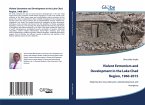The Ecology of Violent Extremism
Perspectives on Peacebuilding and Human Security
Herausgeber: Schirch, Lisa
The Ecology of Violent Extremism
Perspectives on Peacebuilding and Human Security
Herausgeber: Schirch, Lisa
- Gebundenes Buch
- Merkliste
- Auf die Merkliste
- Bewerten Bewerten
- Teilen
- Produkt teilen
- Produkterinnerung
- Produkterinnerung
The Ecology of Violent Extremism brings together leading theorists and practitioners to describe an ecological or systems approach to violent extremism.
Andere Kunden interessierten sich auch für
![The Ecology of Violent Extremism The Ecology of Violent Extremism]() The Ecology of Violent Extremism70,99 €
The Ecology of Violent Extremism70,99 €![Violent Extremism and Development in the Lake Chad Region, 1960-2015 Violent Extremism and Development in the Lake Chad Region, 1960-2015]() Okwudiba AnyikaViolent Extremism and Development in the Lake Chad Region, 1960-201534,99 €
Okwudiba AnyikaViolent Extremism and Development in the Lake Chad Region, 1960-201534,99 €![Conflict, Violent Extremism and Development Conflict, Violent Extremism and Development]() Andrew GlazzardConflict, Violent Extremism and Development43,99 €
Andrew GlazzardConflict, Violent Extremism and Development43,99 €![Violent Extremism in Kenya Violent Extremism in Kenya]() Mugo MugoViolent Extremism in Kenya23,99 €
Mugo MugoViolent Extremism in Kenya23,99 €![Violent Extremism Online Violent Extremism Online]() Violent Extremism Online231,99 €
Violent Extremism Online231,99 €![Roots and Trajectories of Violent Extremism and Terrorism Roots and Trajectories of Violent Extremism and Terrorism]() National Academies of Sciences Engineering and MedicineRoots and Trajectories of Violent Extremism and Terrorism45,99 €
National Academies of Sciences Engineering and MedicineRoots and Trajectories of Violent Extremism and Terrorism45,99 €![Countering Violent and Hateful Extremism in Indonesia Countering Violent and Hateful Extremism in Indonesia]() Countering Violent and Hateful Extremism in Indonesia100,99 €
Countering Violent and Hateful Extremism in Indonesia100,99 €-
-
-
The Ecology of Violent Extremism brings together leading theorists and practitioners to describe an ecological or systems approach to violent extremism.
Hinweis: Dieser Artikel kann nur an eine deutsche Lieferadresse ausgeliefert werden.
Hinweis: Dieser Artikel kann nur an eine deutsche Lieferadresse ausgeliefert werden.
Produktdetails
- Produktdetails
- Verlag: Rowman & Littlefield Publishers
- Seitenzahl: 454
- Erscheinungstermin: 27. August 2018
- Englisch
- Abmessung: 235mm x 157mm x 31mm
- Gewicht: 883g
- ISBN-13: 9781786608468
- ISBN-10: 1786608464
- Artikelnr.: 51145208
- Herstellerkennzeichnung
- Libri GmbH
- Europaallee 1
- 36244 Bad Hersfeld
- gpsr@libri.de
- Verlag: Rowman & Littlefield Publishers
- Seitenzahl: 454
- Erscheinungstermin: 27. August 2018
- Englisch
- Abmessung: 235mm x 157mm x 31mm
- Gewicht: 883g
- ISBN-13: 9781786608468
- ISBN-10: 1786608464
- Artikelnr.: 51145208
- Herstellerkennzeichnung
- Libri GmbH
- Europaallee 1
- 36244 Bad Hersfeld
- gpsr@libri.de
Edited by Lisa Schirch
Forward - Kevin Clements, Toda Peace Institute Preface - Lisa Schirch How
to Use this Book Acronyms Biographies Section 1: The Ecology of Violent
Extremism 1.The Landscape of Terror - Lisa Schirch 2.Mapping Correlations
and Theories of Change in the Ecology of Violent Extremism - Lisa Schirch
3.Unintended Impacts and Ecological Metaphors of Violent Extremism - Lisa
Schirch Section 2: Ecological Analysis of Violent Extremism 4.Alt-Right and
Jihad - Scott Atran 5.Radical Islamist and Radical Christianist Nuclear
Terrorism - Frances Flannery 6.The Private Sector and Violent Extremism -
Stone Conroy 7.The Neurobiology of Violent Extremism - Mari Fitzduff
8.Youth and the Security Sector - Mark Hamilton 9.Advancing a Gender
Perspective and Women's Participation in Preventing and Countering Violent
Extremism - Rafia Bhulai 10.Climate Change and Violent Extremism - Lisa
Schirch Section 3: The Ecology of Counterterrorism 11.Principles of
Effective Counterterrorism - Alistair Millar 12.Overcoming Violent
Extremism in the Middle East: Lessons from the Arab Spring - Sverre
Lodgaard 13.Civil Society Engagement to Prevent Violent Extremism - David
Cortright 14.Six Principles for Enabling State Responses - Lena
Slachmuijlder 15.Legal Restrictions and Counterterrorism - Kay Guinane
16.Proscribing Peace: The Impact of Terrorist Listing on Peacebuilding
Organizations - Teresa Dumasy and Sophie Haspeslagh Section 4: The Ecology
of Preventing/Countering Violent Extremism (P/CVE) 17.The Evolution of CVE
Policy - Elizabeth Hume and Laura Strawmyer 18.Countering Violent Extremism
Framework - Humera Khan and Adnan Ansari 19.CVE in the United States:
Unscientific and Stigmatizing National Security Theater - Arjun S. Sethi
20.Islamisation, Securitization and Peacebuilding Responses to P/CVE -
Mohammed Abu-Nimer 21.CVE, DDR, Social Capital, and the Women, Peace &
Security Agenda- Dean Piedmont and Gabrielle Belli Section 5: The Ecology
of Peacebuilding 22.Addressing Terrorism: A Theory of Change Approach -
John Paul Lederach 23.Negotiation and Violent Extremism: Why Engage, and
Why Not? - William Zartman and Guy Olivier Faure 24.Peacebuilding
Principles for Transforming Violent Extremism - Lena Slachmuijlder
25.Peacebuilding Approaches to Working with Young People - by Saji Prelis,
Michael Shipler, Rachel Walsh, and Lena Slachmuijlder 26.Peacebuilding
Narratives and CVE - Lena Slachmuijlder 27.A Peacebuilding Approach to
Media and Conflict Sensitive Journalism - Myriam Aziz and Lisa Schirch
28.To Defeat Terrorism, Use 'People Power' - Maria J. Stephan and Leanne
Erdberg 29.Preventing Violence through a Trauma Healing Approach - Veronica
Lavet Section 6: Case Studies 30.The Ecology of Violent Extremism in Kenya
- Millicent Otieno 31.P/CVE through Empowering Women Economically and
Socially in Pakistan - Mossarat Qadeem 32.The Radical Muslim and the
Radical Mennonite: An Interfaith Encounter for Peace in Indonesia - Agnes
Chen, Paulus Hartono, and Agus Suyanto 33.What Works to Prevent Violent
Extremism: Lessons from Employment and Education Programs - Rebecca Wolfe
and Keith Proctor 34.A Child-Focused Perspective on the P/CVE Paradigm -
Matthew J.O. Scott 35.Putting Human Dignity at the Center: An Alternative
Perspective on "Countering Violent Extremism" - Nell Bolton and Aaron
Chassy 36.Toward a Synergy of Approaches to Human Security - Policy
Recommendations
to Use this Book Acronyms Biographies Section 1: The Ecology of Violent
Extremism 1.The Landscape of Terror - Lisa Schirch 2.Mapping Correlations
and Theories of Change in the Ecology of Violent Extremism - Lisa Schirch
3.Unintended Impacts and Ecological Metaphors of Violent Extremism - Lisa
Schirch Section 2: Ecological Analysis of Violent Extremism 4.Alt-Right and
Jihad - Scott Atran 5.Radical Islamist and Radical Christianist Nuclear
Terrorism - Frances Flannery 6.The Private Sector and Violent Extremism -
Stone Conroy 7.The Neurobiology of Violent Extremism - Mari Fitzduff
8.Youth and the Security Sector - Mark Hamilton 9.Advancing a Gender
Perspective and Women's Participation in Preventing and Countering Violent
Extremism - Rafia Bhulai 10.Climate Change and Violent Extremism - Lisa
Schirch Section 3: The Ecology of Counterterrorism 11.Principles of
Effective Counterterrorism - Alistair Millar 12.Overcoming Violent
Extremism in the Middle East: Lessons from the Arab Spring - Sverre
Lodgaard 13.Civil Society Engagement to Prevent Violent Extremism - David
Cortright 14.Six Principles for Enabling State Responses - Lena
Slachmuijlder 15.Legal Restrictions and Counterterrorism - Kay Guinane
16.Proscribing Peace: The Impact of Terrorist Listing on Peacebuilding
Organizations - Teresa Dumasy and Sophie Haspeslagh Section 4: The Ecology
of Preventing/Countering Violent Extremism (P/CVE) 17.The Evolution of CVE
Policy - Elizabeth Hume and Laura Strawmyer 18.Countering Violent Extremism
Framework - Humera Khan and Adnan Ansari 19.CVE in the United States:
Unscientific and Stigmatizing National Security Theater - Arjun S. Sethi
20.Islamisation, Securitization and Peacebuilding Responses to P/CVE -
Mohammed Abu-Nimer 21.CVE, DDR, Social Capital, and the Women, Peace &
Security Agenda- Dean Piedmont and Gabrielle Belli Section 5: The Ecology
of Peacebuilding 22.Addressing Terrorism: A Theory of Change Approach -
John Paul Lederach 23.Negotiation and Violent Extremism: Why Engage, and
Why Not? - William Zartman and Guy Olivier Faure 24.Peacebuilding
Principles for Transforming Violent Extremism - Lena Slachmuijlder
25.Peacebuilding Approaches to Working with Young People - by Saji Prelis,
Michael Shipler, Rachel Walsh, and Lena Slachmuijlder 26.Peacebuilding
Narratives and CVE - Lena Slachmuijlder 27.A Peacebuilding Approach to
Media and Conflict Sensitive Journalism - Myriam Aziz and Lisa Schirch
28.To Defeat Terrorism, Use 'People Power' - Maria J. Stephan and Leanne
Erdberg 29.Preventing Violence through a Trauma Healing Approach - Veronica
Lavet Section 6: Case Studies 30.The Ecology of Violent Extremism in Kenya
- Millicent Otieno 31.P/CVE through Empowering Women Economically and
Socially in Pakistan - Mossarat Qadeem 32.The Radical Muslim and the
Radical Mennonite: An Interfaith Encounter for Peace in Indonesia - Agnes
Chen, Paulus Hartono, and Agus Suyanto 33.What Works to Prevent Violent
Extremism: Lessons from Employment and Education Programs - Rebecca Wolfe
and Keith Proctor 34.A Child-Focused Perspective on the P/CVE Paradigm -
Matthew J.O. Scott 35.Putting Human Dignity at the Center: An Alternative
Perspective on "Countering Violent Extremism" - Nell Bolton and Aaron
Chassy 36.Toward a Synergy of Approaches to Human Security - Policy
Recommendations
Forward - Kevin Clements, Toda Peace Institute Preface - Lisa Schirch How
to Use this Book Acronyms Biographies Section 1: The Ecology of Violent
Extremism 1.The Landscape of Terror - Lisa Schirch 2.Mapping Correlations
and Theories of Change in the Ecology of Violent Extremism - Lisa Schirch
3.Unintended Impacts and Ecological Metaphors of Violent Extremism - Lisa
Schirch Section 2: Ecological Analysis of Violent Extremism 4.Alt-Right and
Jihad - Scott Atran 5.Radical Islamist and Radical Christianist Nuclear
Terrorism - Frances Flannery 6.The Private Sector and Violent Extremism -
Stone Conroy 7.The Neurobiology of Violent Extremism - Mari Fitzduff
8.Youth and the Security Sector - Mark Hamilton 9.Advancing a Gender
Perspective and Women's Participation in Preventing and Countering Violent
Extremism - Rafia Bhulai 10.Climate Change and Violent Extremism - Lisa
Schirch Section 3: The Ecology of Counterterrorism 11.Principles of
Effective Counterterrorism - Alistair Millar 12.Overcoming Violent
Extremism in the Middle East: Lessons from the Arab Spring - Sverre
Lodgaard 13.Civil Society Engagement to Prevent Violent Extremism - David
Cortright 14.Six Principles for Enabling State Responses - Lena
Slachmuijlder 15.Legal Restrictions and Counterterrorism - Kay Guinane
16.Proscribing Peace: The Impact of Terrorist Listing on Peacebuilding
Organizations - Teresa Dumasy and Sophie Haspeslagh Section 4: The Ecology
of Preventing/Countering Violent Extremism (P/CVE) 17.The Evolution of CVE
Policy - Elizabeth Hume and Laura Strawmyer 18.Countering Violent Extremism
Framework - Humera Khan and Adnan Ansari 19.CVE in the United States:
Unscientific and Stigmatizing National Security Theater - Arjun S. Sethi
20.Islamisation, Securitization and Peacebuilding Responses to P/CVE -
Mohammed Abu-Nimer 21.CVE, DDR, Social Capital, and the Women, Peace &
Security Agenda- Dean Piedmont and Gabrielle Belli Section 5: The Ecology
of Peacebuilding 22.Addressing Terrorism: A Theory of Change Approach -
John Paul Lederach 23.Negotiation and Violent Extremism: Why Engage, and
Why Not? - William Zartman and Guy Olivier Faure 24.Peacebuilding
Principles for Transforming Violent Extremism - Lena Slachmuijlder
25.Peacebuilding Approaches to Working with Young People - by Saji Prelis,
Michael Shipler, Rachel Walsh, and Lena Slachmuijlder 26.Peacebuilding
Narratives and CVE - Lena Slachmuijlder 27.A Peacebuilding Approach to
Media and Conflict Sensitive Journalism - Myriam Aziz and Lisa Schirch
28.To Defeat Terrorism, Use 'People Power' - Maria J. Stephan and Leanne
Erdberg 29.Preventing Violence through a Trauma Healing Approach - Veronica
Lavet Section 6: Case Studies 30.The Ecology of Violent Extremism in Kenya
- Millicent Otieno 31.P/CVE through Empowering Women Economically and
Socially in Pakistan - Mossarat Qadeem 32.The Radical Muslim and the
Radical Mennonite: An Interfaith Encounter for Peace in Indonesia - Agnes
Chen, Paulus Hartono, and Agus Suyanto 33.What Works to Prevent Violent
Extremism: Lessons from Employment and Education Programs - Rebecca Wolfe
and Keith Proctor 34.A Child-Focused Perspective on the P/CVE Paradigm -
Matthew J.O. Scott 35.Putting Human Dignity at the Center: An Alternative
Perspective on "Countering Violent Extremism" - Nell Bolton and Aaron
Chassy 36.Toward a Synergy of Approaches to Human Security - Policy
Recommendations
to Use this Book Acronyms Biographies Section 1: The Ecology of Violent
Extremism 1.The Landscape of Terror - Lisa Schirch 2.Mapping Correlations
and Theories of Change in the Ecology of Violent Extremism - Lisa Schirch
3.Unintended Impacts and Ecological Metaphors of Violent Extremism - Lisa
Schirch Section 2: Ecological Analysis of Violent Extremism 4.Alt-Right and
Jihad - Scott Atran 5.Radical Islamist and Radical Christianist Nuclear
Terrorism - Frances Flannery 6.The Private Sector and Violent Extremism -
Stone Conroy 7.The Neurobiology of Violent Extremism - Mari Fitzduff
8.Youth and the Security Sector - Mark Hamilton 9.Advancing a Gender
Perspective and Women's Participation in Preventing and Countering Violent
Extremism - Rafia Bhulai 10.Climate Change and Violent Extremism - Lisa
Schirch Section 3: The Ecology of Counterterrorism 11.Principles of
Effective Counterterrorism - Alistair Millar 12.Overcoming Violent
Extremism in the Middle East: Lessons from the Arab Spring - Sverre
Lodgaard 13.Civil Society Engagement to Prevent Violent Extremism - David
Cortright 14.Six Principles for Enabling State Responses - Lena
Slachmuijlder 15.Legal Restrictions and Counterterrorism - Kay Guinane
16.Proscribing Peace: The Impact of Terrorist Listing on Peacebuilding
Organizations - Teresa Dumasy and Sophie Haspeslagh Section 4: The Ecology
of Preventing/Countering Violent Extremism (P/CVE) 17.The Evolution of CVE
Policy - Elizabeth Hume and Laura Strawmyer 18.Countering Violent Extremism
Framework - Humera Khan and Adnan Ansari 19.CVE in the United States:
Unscientific and Stigmatizing National Security Theater - Arjun S. Sethi
20.Islamisation, Securitization and Peacebuilding Responses to P/CVE -
Mohammed Abu-Nimer 21.CVE, DDR, Social Capital, and the Women, Peace &
Security Agenda- Dean Piedmont and Gabrielle Belli Section 5: The Ecology
of Peacebuilding 22.Addressing Terrorism: A Theory of Change Approach -
John Paul Lederach 23.Negotiation and Violent Extremism: Why Engage, and
Why Not? - William Zartman and Guy Olivier Faure 24.Peacebuilding
Principles for Transforming Violent Extremism - Lena Slachmuijlder
25.Peacebuilding Approaches to Working with Young People - by Saji Prelis,
Michael Shipler, Rachel Walsh, and Lena Slachmuijlder 26.Peacebuilding
Narratives and CVE - Lena Slachmuijlder 27.A Peacebuilding Approach to
Media and Conflict Sensitive Journalism - Myriam Aziz and Lisa Schirch
28.To Defeat Terrorism, Use 'People Power' - Maria J. Stephan and Leanne
Erdberg 29.Preventing Violence through a Trauma Healing Approach - Veronica
Lavet Section 6: Case Studies 30.The Ecology of Violent Extremism in Kenya
- Millicent Otieno 31.P/CVE through Empowering Women Economically and
Socially in Pakistan - Mossarat Qadeem 32.The Radical Muslim and the
Radical Mennonite: An Interfaith Encounter for Peace in Indonesia - Agnes
Chen, Paulus Hartono, and Agus Suyanto 33.What Works to Prevent Violent
Extremism: Lessons from Employment and Education Programs - Rebecca Wolfe
and Keith Proctor 34.A Child-Focused Perspective on the P/CVE Paradigm -
Matthew J.O. Scott 35.Putting Human Dignity at the Center: An Alternative
Perspective on "Countering Violent Extremism" - Nell Bolton and Aaron
Chassy 36.Toward a Synergy of Approaches to Human Security - Policy
Recommendations








